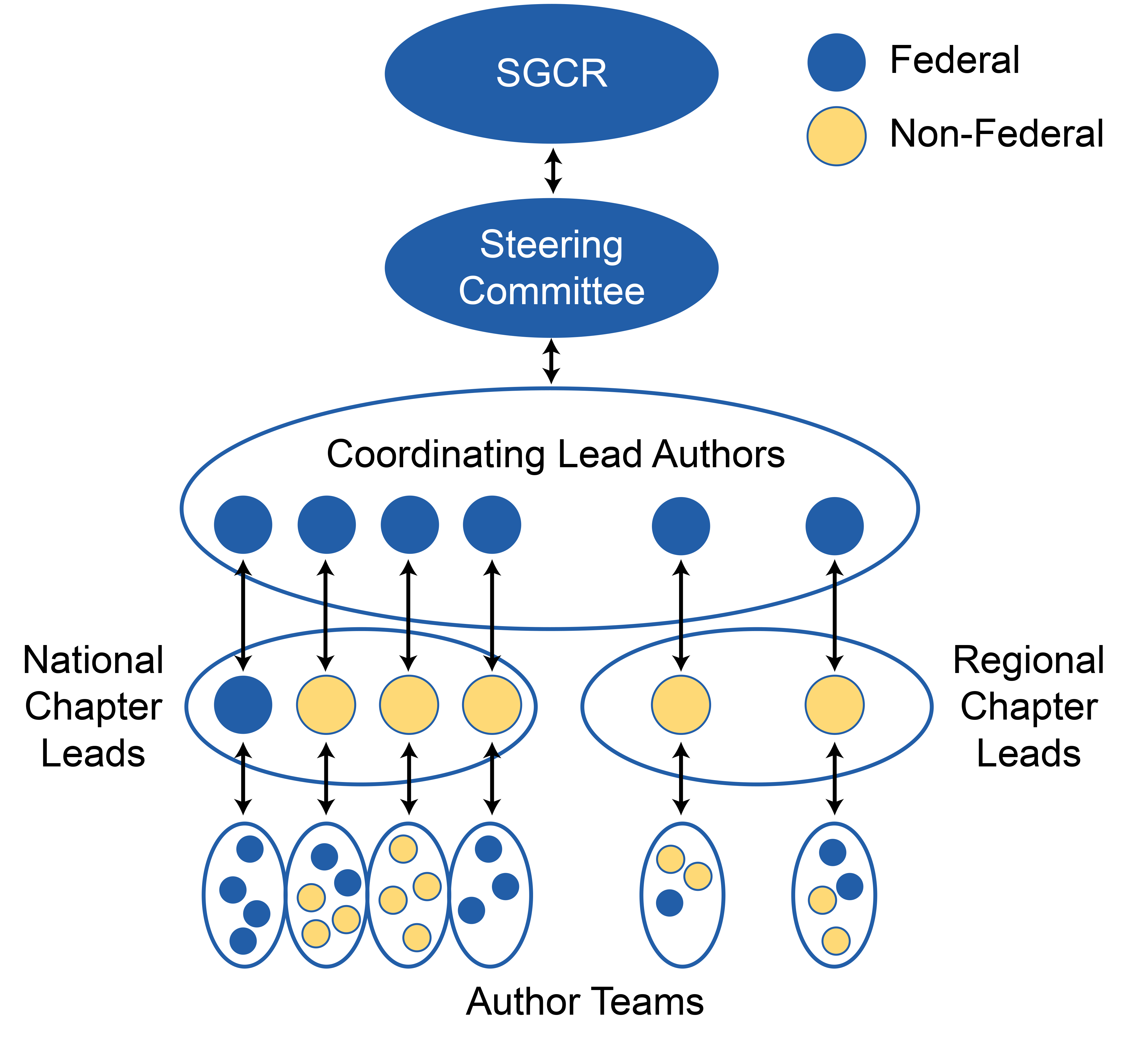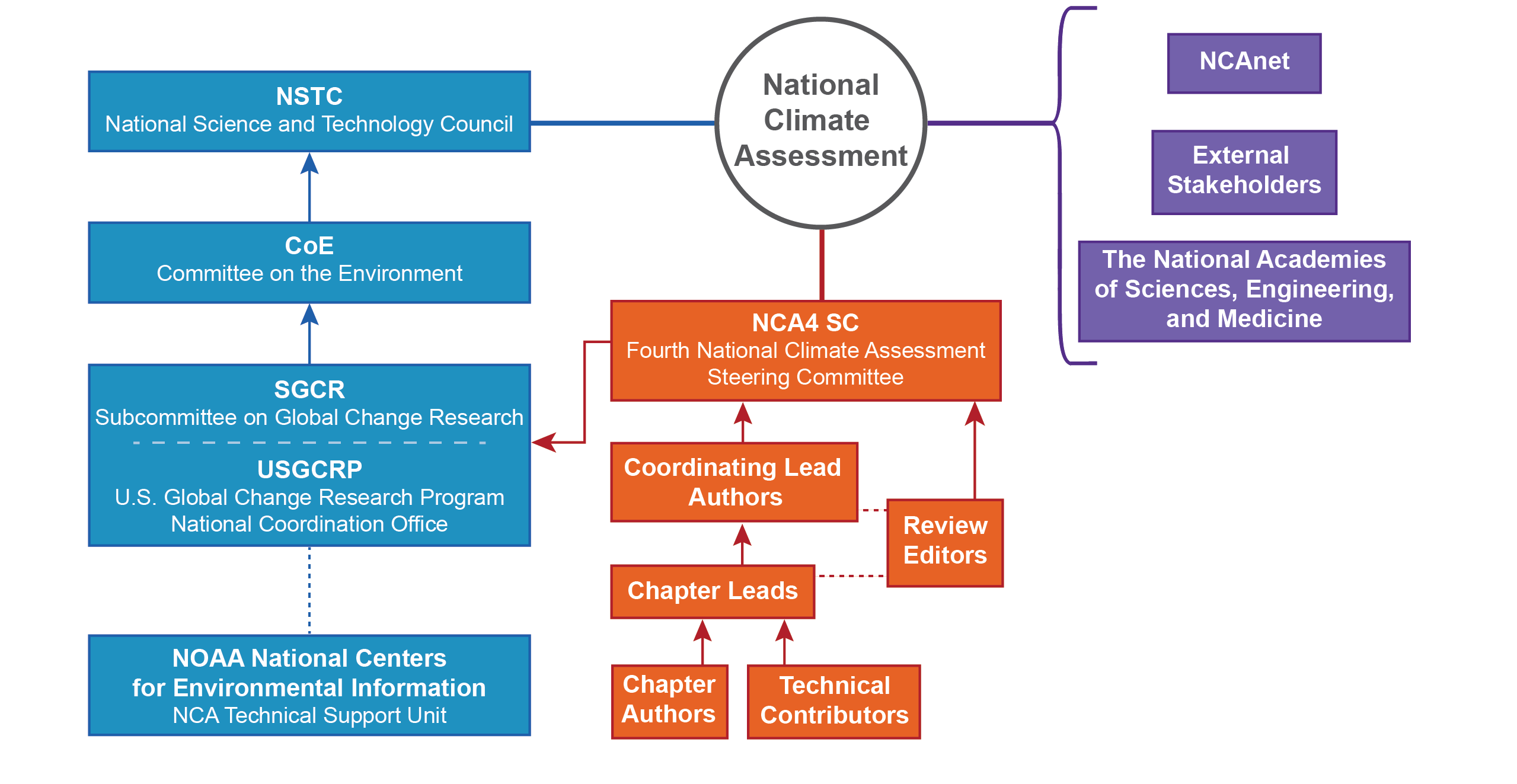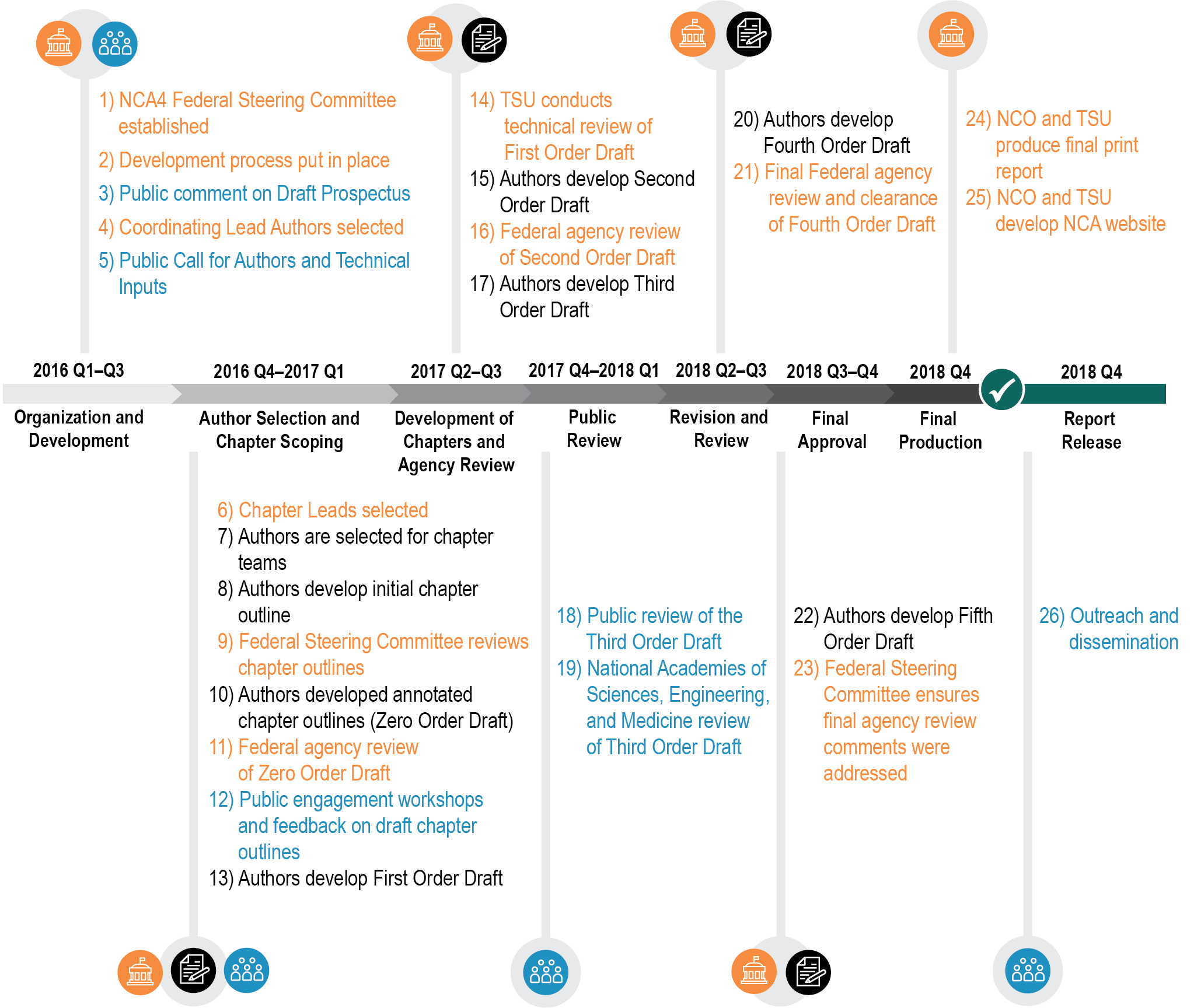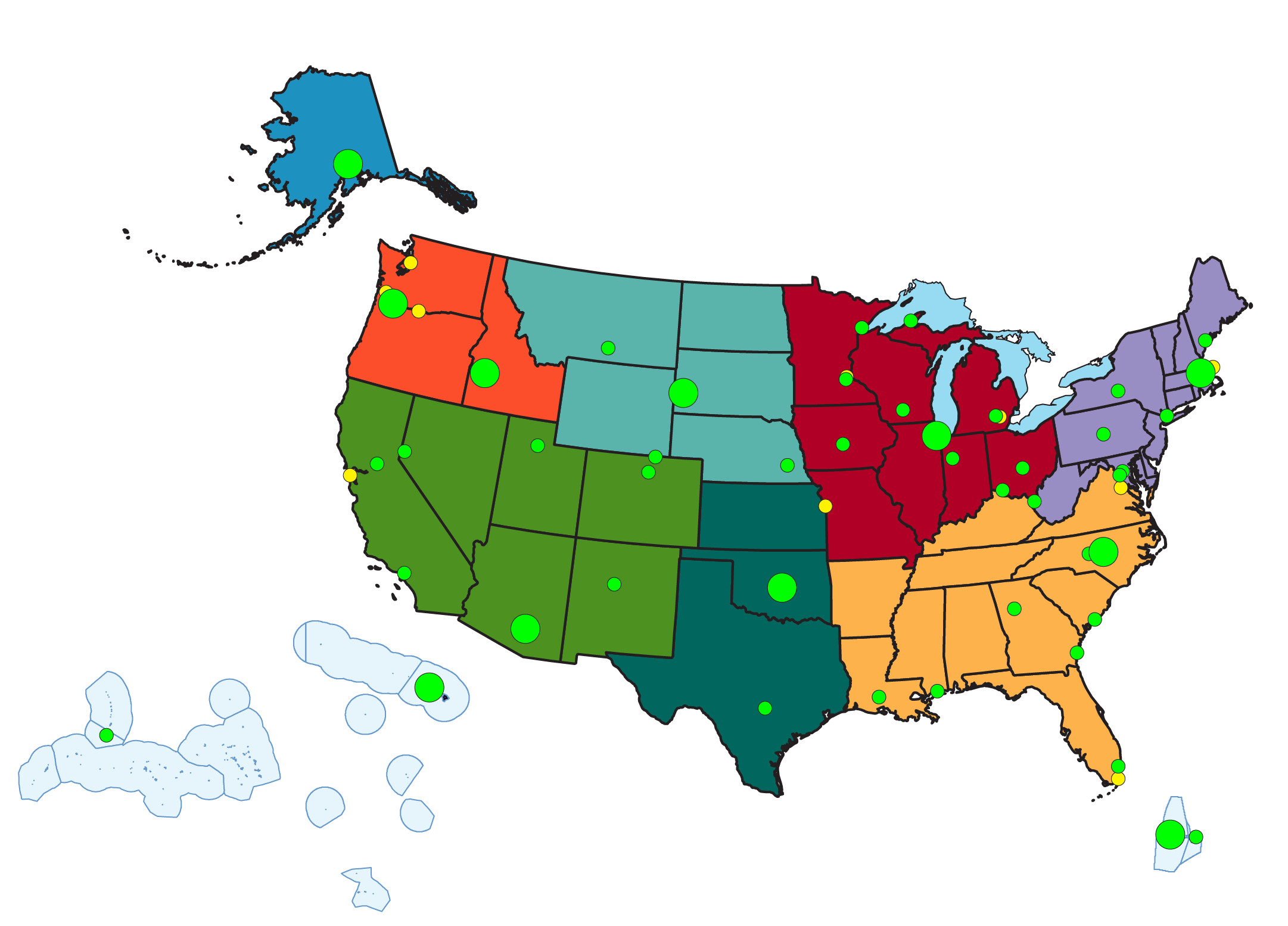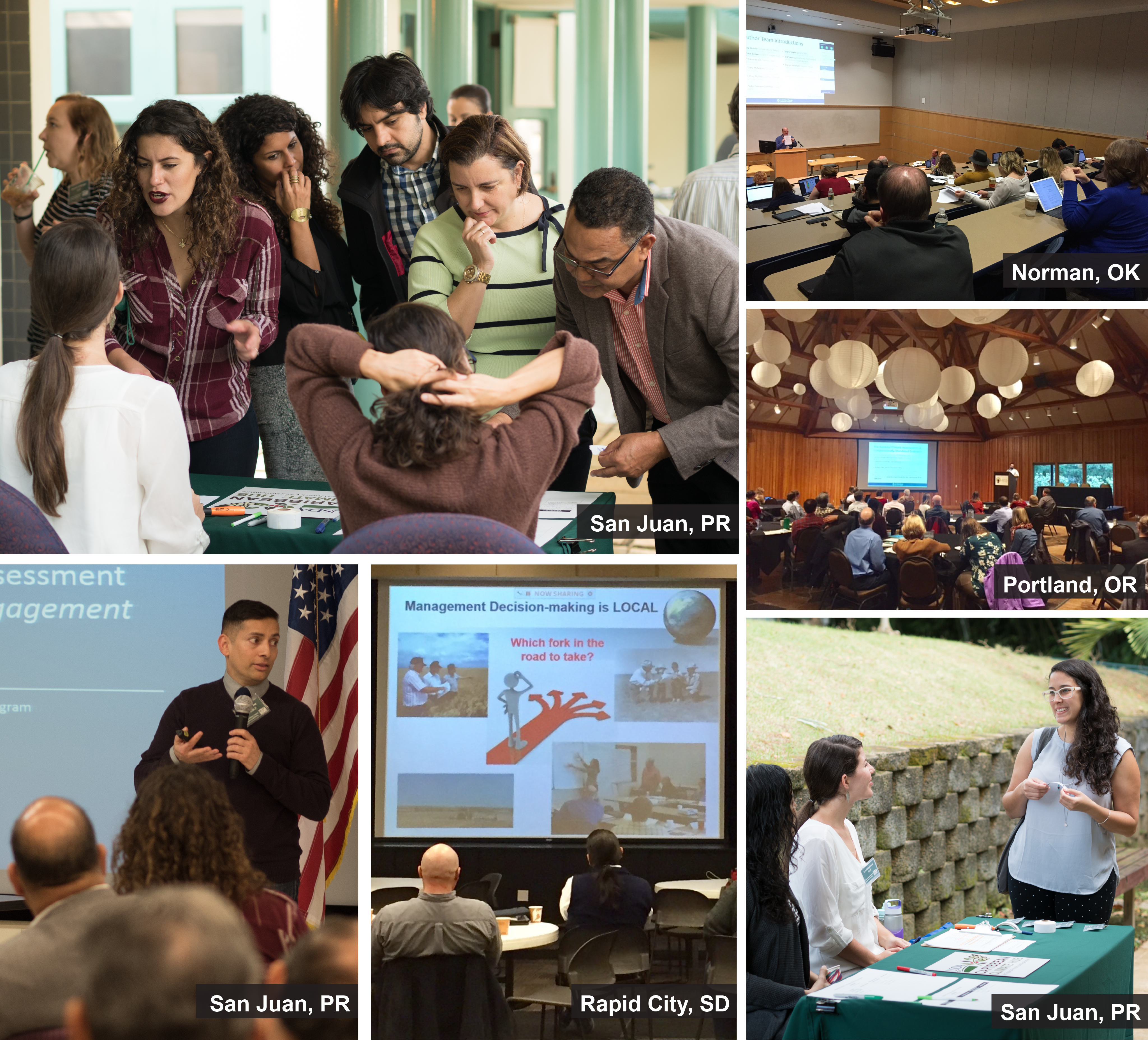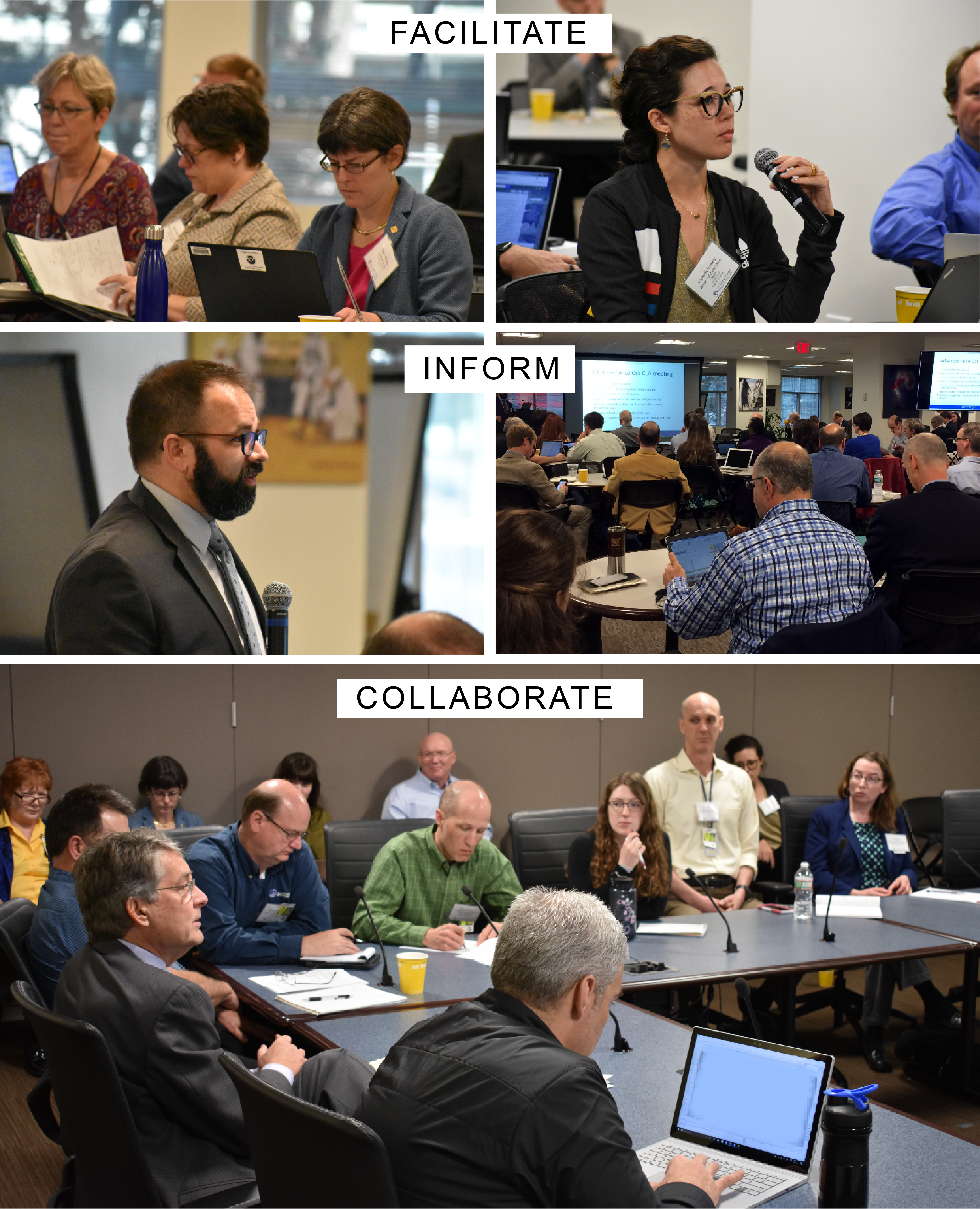In May 2015, a Federal Register Notice7 requested information to help inform the structure and content of USGCRP’s sustained National Climate Assessment process, which NCA4 is a part of. In early 2016, the SGCR Principals designated the NCA4 SC to lead NCA4 development, and the NCA4 SC began its work, building on prior work from the Interagency National Climate Assessment (INCA) Working Group, the NCADAC, experiences of TSU and NCO staff, and feedback from the aforementioned public call for information (Figure A1.4).
In July 2016, a Federal Register Notice8 was published, seeking input on the draft outline for NCA4. Subsequently, a Federal Register Notice9 was published in late August 2016, serving as both a call for regional Chapter Leads and other authors (open call for 30 days) and a call for technical inputs (this part of the call was open for a longer time period, until mid-January 2017).
Concurrent with these public calls for nominations and technical inputs, the NCA4 SC, NCO staff, and TSU staff developed guidance documents for use during the development of NCA4, ranging from chapter and Traceable Accounts templates to style guides and a literature resource database. Risk-based framing was integrated into the chapter templates and other drafting guidance. Authors had access throughout the process to scientific resources and writing guidance materials on a password-protected Resources website, hosted by the TSU, that also served as a collaboration space for authors.
Author Selection, Role, and Preliminary Work (Autumn 2016)
In the fall of 2016, the NCA4 SC selected one or two federal Coordinating Lead Authors (CLAs) for each chapter, based on criteria that included expertise and experience and that ensured a variety of perspectives. As the author teams were being assembled (described below), the CLAs and many of the CLs began scoping their chapters. In addition, in October 2016, a CLA meeting was held in Washington, DC, to provide context and guidance for the CLAs moving forward with the NCA4 process.
National Chapter Leads (NCLs), for the topic and response chapters, were selected by the Agency Chapter Lead for each national chapter. The NCA4 SC selected the Regional Chapter Leads (RCLs) from a pool of nominated authors derived from a call for nominations in the Federal Register Notice,9 described above. These NCLs and RCLs, with input and guidance from the NCA4 SC, selected federal and nonfederal Chapter Authors (CAs) to establish chapter author teams. CAs were identified based not only on the expertise and experience they would bring to the chapter, but also a commitment to ensuring that a diverse range of perspectives would be reflected in the drafting process. In addition, Technical Contributors (TCs) were enlisted at the discretion of the CL to provide specific technical input to the chapter as needed. Each chapter had a primary and backup NCO Point of Contact (POC) who supported the chapter team, provided clarity on drafting guidance, facilitated conversations, and assisted the CLA in identifying crosscutting issues.
Initial Chapter Outlines (December 2016 – January 2017)
Author Training and Drafting
Each of the author teams met multiple times by phone, web, and in person and produced multiple iterations of their chapters since beginning work in October 2016. Traceable Accounts developed for the chapters provide transparent information about the authors’ deliberations to arrive at their expert judgment regarding the level of certainty related to the Key Messages of their chapter.
Monthly calls/webinars were generally held with all authors in order to provide them with updates and to address a variety of topics in an effort to ensure consistency across the report and to keep the Assessment progressing in a timely manner. In addition, USGCRP coordinated 14 author training webinars on the following topics:
Available scenarios products and how to use them
The EPA’s Climate Change Impacts and Risk Analysis (CIRA) project10
Lessons learned through previous assessments
Key Message and Traceable Account development
A walkthrough of the website for scenario products11
Available regional- and local-scale climate variables, through the Localized Constructed Analogs (LOCA) system (See App. 3: Data & Scenarios for more information)
Metadata requirements and the Global Change Information System (GCIS)
Climate change indicators
A report from the National Academies of Sciences, Engineering, and Medicine (NASEM) on Characterizing Risk in Climate Assessments12
Risk-based framing
Climate Change and Indigenous Peoples: A Synthesis of Current Impacts and Experiences report13
NCA4 Volume I: Climate Science Special Report (CSSR)
NOAA’s State Climate Summaries14
External, expert peer-review of the draft report by an ad hoc panel of NASEM15
All author training webinars were recorded and archived on the password-protected Resources portal for authors to access at their convenience throughout the process.
Cross-Chapter Coordination
A key component of success in any broad assessment effort is a means of facilitating cross-chapter coordination. During NCA4, this was done throughout the drafting and review processes. The CLA-CL1 meeting facilitated high-level information sharing among chapter leadership, especially through the aforementioned speed-dating meetings between chapters. The Resources website also provided a forum for interim drafts to be posted and viewed by all author teams.
Specific author teams employed many other techniques. For example, the regional authors working on tribal and Indigenous topics began having regular phone meetings in the winter of 2017 and then began meeting with the authors of the national-level "Tribes and Indigenous Peoples" chapter to discuss consistent terminology and language framing around these topics. Authors of another national-scale chapter (Ch. 10: Ag & Rural) set up phone calls with authors from each of the regional chapters to ensure appropriate coverage of topical issues throughout the regions and to facilitate the roll-up of regional issues related to agriculture and rural communities to the higher-level synthesis chapter.
Review Editor Selection and Role
The NCA4 Federal Steering Committee selected Review Editors (REs) from a slate of candidates nominated through a public open call in the summer of 2017.16 For their assigned chapter(s), REs ensured that all substantive comments submitted during the Public Comment Period and via an expert review panel of NASEM were appropriately addressed and documented. REs advised CLs on how to handle contentious issues and ensured that significant scientific uncertainties were reflected adequately in the text of NCA4. REs did not provide additional comments on assigned draft chapters but instead focused on the materials derived from the Public Comment Period and NASEM review. REs ensured that each and every comment had been considered by the author team and that the “annotation” (the written response to the comment) was responsive to the comment and indicated any revision made to the chapter(s), including the scientific or logical rationale for said action. REs helped the CLs ensure that the response to each review comment matched the final text of the revised, post-public/NASEM review draft.
All-Author Meeting
On March 26–28, 2018, all chapter authors and review editors were invited to participate in a 2.5-day all-author workshop in Bethesda, Maryland. The workshop gave authors the opportunity to finalize cross-chapter references and finish edits in response to both public and NASEM reviews of the Third Order Draft.
Review Processes
To begin the writing process, author teams were instructed to develop high-level chapter outlines late in 2016 in light of comments received on the draft prospectus8 and guidance provided to authors. The NCA4 Federal Steering Committee reviewed and provided comments on these high-level chapter outlines, which resulted in annotated outlines (Zero Order Drafts) provided to the SGCR for interagency review in January 2017. Comments from this interagency review, alongside input from the suite of public engagement events held throughout the spring of 2017, informed the development of a full First Order Draft.
With the receipt of the full First Order Draft in mid-June 2017, the TSU began an iterative technical editing process with the authors of each chapter to ensure that content was scientifically accurate, that topics were addressed consistently across chapters, and that the text and figures were accessible to the target audience. This process resulted in a Second Order Draft (SOD). A second round of interagency, SGCR-led review of this SOD occurred in the summer of 2017. Consequently, authors revised their chapters in response to these interagency comments, resulting in a Third Order Draft (TOD). This TOD was then released on November 3, 2017, for review by the public.16 The three-month public review period allowed individuals and groups to examine the draft and provide comments to ensure that the report 1) presented the science accurately, 2) responded to user needs, and 3) relayed its findings in a clear and consistent manner. By the time the Public Comment Period closed on January 31, 2018, the online comment system had received 3,416 comments representing diverse perspectives from over 1,100 registrants (although a smaller number of individual registrants actually submitted comments). Concurrent to this public review period, NASEM convened an expert ad hoc committee to review the TOD and provided the authors with a formal, peer-reviewed external expert review.15
Chapter author teams amended the TOD in response to these public and NASEM comments; they were required to respond to each and every comment. Review Editors evaluated the adequacy of the responses to the comments on each chapter. The public comments and the chapter authors’ responses to those comments are available online with the final report (nca2018.globalchange.gov).
The Fourth Order Draft (4OD) that resulted from the revisions made in response to the public and NASEM comments was then circulated to the interagency again for final federal review and clearance in late April 2018. Any comments that were submitted by the early June 2018 deadline were addressed by the authors during the summer of 2018, resulting in a Fifth Order Draft. In late summer 2018, each Agency’s Federal Steering Committee member reviewed this final draft of the report to ensure that any agency comments submitted by the June deadline were adequately addressed.
NCA Final Report
After a production and layout phase in the autumn of 2018, a final public version of the report was published as a downloadable PDF in December 2018; an accompanying website (nca2018.globalchange.gov) was unveiled at the same time. A number of derivative products, including a “Report-in-Brief” document, were produced in addition to the full report.
Resources Available for Authors
The Resources website served as the primary compendium of guidance documents, recordings of training webinars, drafts in progress, and many other resources for authors. In addition, the Resources site contained forms to submit figure requests and the associated, required metadata.
Technical Inputs
A public call for technical inputs9 resulted in the submission of more than 400 peer-reviewed journal articles, reports, and other contributions authored by hundreds of individuals from academia, industry, various levels of government, and nongovernmental organizations. Alongside this public set of technical inputs, the USGCRP NCO conducted a survey of high-impact scientific journals and other peer-reviewed sources to develop a searchable-by-chapter database of over 1,200 articles and reports for NCA4 authors to consider in their assessment.
In addition, the TSU climate science team developed 51 state climate summaries (one for each state, with a 51st summary on Puerto Rico and the U.S. Virgin Islands) to meet a demand for state-level information in the wake of NCA3.14 The summaries cover assessment topics directly related to NOAA’s mission, specifically historical climate variations and trends, future climate model projections of climate conditions during the 21st century, and past and future conditions of sea level and coastal flooding. Furthermore, EPA produced 50 state climate summaries plus one each for Guam, Puerto Rico, and the U.S. Virgin Islands, looking at historical climate impacts.17
The Multi-Model Framework for Quantitative Sectoral Impacts Analysis: A Technical Report for the Fourth National Climate Assessment (CIRA2.0) was produced as a technical input to NCA4 and informs many chapters.10 This report estimates the physical and monetary benefits to the United States of reducing global greenhouse gas emissions in 2050 and 2090 for more than 20 sectors of the American economy. Other technical reports produced since NCA3 and used as technical inputs to NCA4 include the U.S. Forest Service’s Effects of Drought on Forests and Rangelands in the United States: A Comprehensive Science Synthesis18 and Climate Change and Indigenous Peoples: A Synthesis of Current Impacts and Experiences.13
Special Assessment Reports
A number of federally produced scientific assessment reports provide a robust foundation from which NCA4 authors drew. An illustrative list of such USGCRP-sustained assessment products include:
The Climate Science Special Report (CSSR),15 released in November 2017, is Volume I of NCA4. It provides the scientific underpinnings for NCA4 and serves as an update of the physical science as presented in NCA3.2 Topics include detection and attribution; precipitation change; droughts, floods, and wildfire; extreme storms; sea level rise; ocean acidification; mitigation; potential surprises; and more.
The Second State of the Carbon Cycle (SOCCR2)19 was released in December 2018 and provides an update on carbon cycle science across North America that informs several NCA4 chapters.
The Impacts of Climate Change on Human Health in the United States: A Scientific Assessment (referred to as the “Climate and Health Assessment”) was released in April 2016 and strengthens our understanding of the linkages between climate change and health. It serves as an important input to NCA4,20 covering such issues as temperature-related death and illness; air quality impacts; extreme events; vector-borne diseases; waterborne illness; food safety, nutrition, and distribution; mental health and well-being; and populations of concern.
The Climate Change, Global Food Security, and the U.S. Food System assessment was released in December 2015 and identifies climate change impacts on global food security. It provides input to many chapters,21 covering such issues as non-climate drivers of food systems and security; models, scenarios, and projections of socioeconomic change; integrated assessment models of agricultural and food systems; food availability and stability; food access and stability; food utilization and stability; and global food security and the United States.
The Third National Climate Assessment (NCA3) was released in 2014 and covered many of the same sectors and geographical regions of the United States, providing a foundation for the sectors and regions in NCA4.2 NCA4 includes several new national topic chapters and regions as a result of feedback from the public for such information.
Engagement Activities
The NCA Engagement Strategy,22 developed for NCA3 and expanded for NCA4, provides a vision for participation, outreach, communications, and education processes that help make the NCA process and products more accessible and useful to many audiences. The overall goal of engagement is to create a more effective and successful NCA that is informed by and responsive to user needs—improving the processes and products of the effort so that they are credible and salient and build the capacity of participants to engage in the creation and use of these processes and products for decision-making.22 The strategy describes a number of mechanisms through which scientific and technical experts, decision-makers, and members of the general public might learn about and participate in the NCA process.
The NCO organized listening sessions, symposia, webinars, and other sessions at professional society meetings to provide updates on the NCA process, solicit broad input from subject matter experts, and collect feedback on the approach, topics, and methodologies under consideration.
A series of Regional Informational Webinars were conducted in September 2016 to solicit technical inputs and nominations for authors and to discuss the NCA4 process. These included webinars targeted at each of the NCA4 regions (with the Southeast and U.S. Caribbean being combined), as well as one webinar focused on tribal and Indigenous communities and a final, national-level webinar intended for a general audience.
In addition, a series of Public Comment Period Webinars were offered from November 2017 through January 2018 to raise awareness of the opportunity for the public to review the Third Order Draft of NCA4.
NCO staff also provided substantive updates on process and development directly to NCA authors in weekly emails and monthly calls. The broader public was kept abreast of developments through regular updates on the USGCRP website: http://www.globalchange.gov/nca4.
NCAnet Activities
USGCRP hosts an NCAnet (NCA network) Conversation on a roughly bimonthly basis (since January 2012). Briefly, NCAnet is a network of organizations working with the NCA to engage producers and users of assessment information across the United States. Participants (http://ncanet.usgcrp.gov/partners) help extend the reach of USGCRP assessment products, including the NCA and reports like the Climate and Health Assessment (https://health2016.globalchange.gov/), through the development of assessment-related capacities and products. These efforts have included collecting and synthesizing data or other technical and scientific information relevant to current and future assessments, disseminating findings to various users of assessment information, engaging assessment information producers and users, supporting assessment-related events, and producing communications materials related to the NCA and other assessment findings.
More information on NCAnet, including a list of NCAnet affiliates and presentations, as well as information on becoming a member, is available at http://ncanet.usgcrp.gov.
Regional Engagement Workshops and Subsequent Author Meetings
In order to gain feedback from the residents of the various NCA4 regions, author teams held workshops in various locations and invited members of the public and interested stakeholders to listen to presentations on the proposed chapter outlines. Attendees were then asked to provide feedback to authors to help clarify the priorities of the region, relay valuable technical inputs, and otherwise inform the development of the chapter. Reports from these workshops are available online at https://www.globalchange.gov/content/nca4-engagement-activities.
Alaska Regional Engagement Workshop, Hub: Anchorage, Alaska, February 2017
Northeast Regional Engagement Workshop, Hub: Boston, Massachusetts, with six satellite locations, February 2017
Southwest Regional Engagement Workshop, Hub: Tucson, Arizona, with six satellite locations, February 2017
Northern Great Plains Regional Engagement Workshop, Hub: Rapid City, South Dakota, with three satellite locations, February 2017
Hawai‘i and U.S.-Affiliated Pacific Islands Regional Engagement Workshop, Hub: Honolulu, Hawai‘i, March 2017
Midwest Regional Engagement Workshop, Hub: Chicago, Illinois, with nine satellite locations, March 2017
Southern Great Plains Regional Engagement Workshop, Hub: Norman, Oklahoma, with one satellite location, March 2017
U.S. Caribbean Regional Engagement Workshop, Hub: San Juan, Puerto Rico, with one satellite location, March 2017
Southeast Regional Engagement Workshop, Hub: Raleigh, North Carolina, with seven satellite locations, March 2017
Northwest Regional Engagement Workshop, Hubs: Portland, Oregon, and Boise, Idaho, March 2017
Listening Sessions
Listening sessions were held in a number of places where a full workshop was not appropriate or possible. Listening sessions included a brief overview presentation on the NCA, with some specifics on the chapters of interest to the given audience. Stakeholders were then encouraged to provide feedback on the content of the presentation, as well as any additional information or resources that might be useful for authors to understand.
Great Lakes Adaptation Forum, October 2016, Ann Arbor, Michigan
The Kresge Foundation, November 2016, Washington, DC
American Geophysical Union Annual Meeting, December 2016, San Francisco, California
American Meteorological Society Annual Meeting, January 2017, Seattle, Washington
Transportation Research Board Aviation Climate Change Subcommittee, January 2017, Washington, DC
National Council for Science and the Environment National Meeting, January 2017, Crystal City, Virginia
Alaska Center for Climate Assessment and Policy Webinar, February 2017
Association for the Sciences of Limnology and Oceanography, March 2017, Honolulu, Hawai‘i
National Adaptation Forum, May 2017, St. Paul, Minnesota
Presentations
Many presentations were given to relevant stakeholder audiences through the development of this report. An illustrative listing of NCA4-related presentations made by NCO staff includes:
North American Carbon Program Science Leadership Group–NCA4 Overview, October 2016, Crystal City, Virginia
Resilience AmeriCorps Federal Resource Fair, October 2016, Alexandria, Virginia
2016 Belmont Forum Plenary Meeting, November 2016, Doha, Qatar
7th Annual Northwest Climate Conference, November 2016, Stevenson, Washington
American Lung Association, December 2016, Washington, DC
American Geophysical Union Annual Meeting (NASA and NOAA booths), December 2016, San Francisco, California
Transportation Research Board–Climate Change and Energy Task Force, January 2017, Washington, DC
American Meteorological Society Annual Meeting Booth, January 2017, Seattle, Washington
National Council for Science and the Environment Annual Meeting, January 2017, Crystal City, Virginia
American Association for the Advancement of Science Annual Meeting, February 2017, Boston, Massachusetts
2017 Joint NACP Ameriflux Principal Investigators Meeting, March 2017, North Bethesda, Maryland
Southeast & Caribbean Climate Community of Practice 2017 Meeting, April 2017, Charleston, South Carolina
Association of State Floodplain Managers Annual Conference, May 2017, Kansas City, Missouri
National Adaptation Forum, May 2017, St. Paul, Minnesota
Conference of Mayors Annual Meeting, June 2017, Miami Beach, Florida
Ecological Society of America Annual Meeting, August 2017, Austin, Texas
American Chemical Society National Meeting, August 2017, Washington, DC
Pacific Northwest Climate Conference, October 2017, Tacoma, Washington
Geological Society of America Annual Meeting, October 2017, Seattle, Washington
Guest lecture at Boston University, November 2017 (virtual)
American Geophysical Union Fall Meeting, December 2017, New Orleans, Louisiana
American Meteorological Society Annual Meeting, January 2018, Austin, Texas
National Council for Science and the Environment Annual Meeting, January 2018, Crystal City, Virginia
Guest lecture at San Francisco State University, February 2018 (virtual)
National Association of Regulatory Utility Commissioners Winter Policy Summit, February 2018, Washington, DC
Air and Waste Management Association webinar, February 2018 (virtual)
American Association for the Advancement of Science Annual Meeting, February 2018, Austin, Texas
Center for Climate and Energy Solutions Business Environmental Leadership Council Spring Meeting, March 2018, Washington, DC
Guest lecture at University of Illinois, April 2018 (virtual)
Guest lecture at University of Arizona, April 2018 (virtual)
Electric Power Research Institute (EPRI) Energy 7 Climate Research Seminar, May 2018, Washington, DC
Adaptation Futures Conference, June 2018, Cape Town, South Africa
American Association of State Climatologists Annual Meeting, June 2018, Nebraska City, Nebraska
National Academies of Sciences, Engineering, and Medicine Committee to Advise USGCRP, July 2018, Washington, DC
Ecological Society of America Annual Meeting, August 2018, New Orleans, Louisiana
National Academies of Sciences, Engineering, and Medicine Workshop on Subnational Climate Assessments, August 2018, Washington, DC
Great Lakes Adaptation Forum, September 2018, Ann Arbor, Michigan
Sigma Xi Annual Meeting, October 2018, Burlingame, California
American Geophysical Union Fall Meeting, December 2018, Washington, DC

